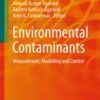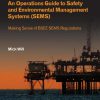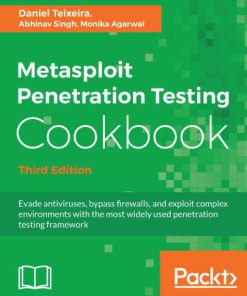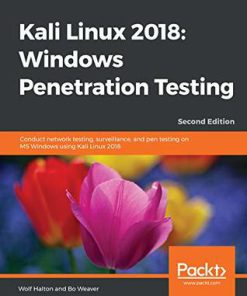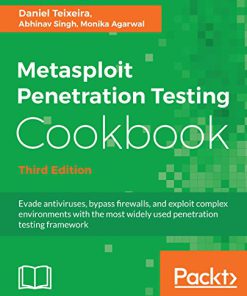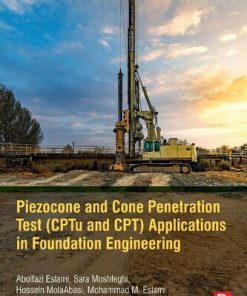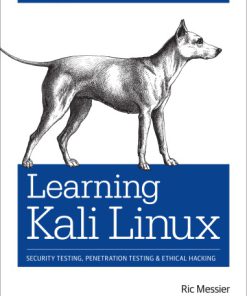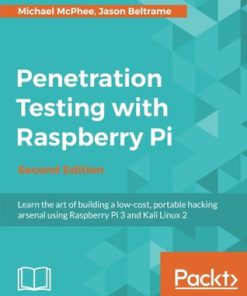Cone Penetration Testing 2018 1st Edition by Michael Hicks, Federico Pisanò, Joek Peuchen 0429000480 9780429000485
$50.00 Original price was: $50.00.$25.00Current price is: $25.00.
Cone Penetration Testing 2018 1st Edition by Michael Hicks, Federico Pisanò, Joek Peuchen – Ebook PDF Instant Download/Delivery: 0429000480, 9780429000485
Full download Cone Penetration Testing 2018 1st Edition after payment
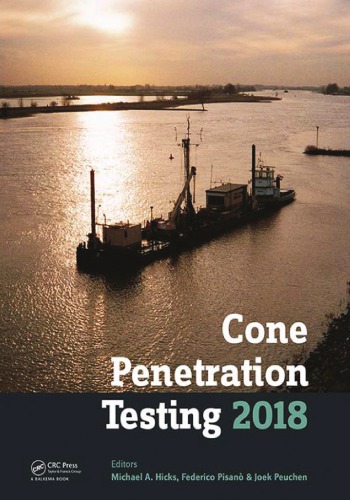
Product details:
ISBN 10: 0429000480
ISBN 13: 9780429000485
Author: Michael A. Hicks, Federico Pisanò, Joek Peuchen
Cone Penetration Testing 2018contains the proceedings of the 4th International Symposium on Cone Penetration Testing (CPT’18, Delft, The Netherlands, 21-22 June 2018), and presents the latest developments relating to the use of cone penetration testing in geotechnical engineering. It focuses on the solution of geotechnical challenges using the cone penetration test (CPT), CPT add-on measurements and companion in-situ penetration tools (such as full flow and free fall penetrometers), with an emphasis on practical experience and application of research findings. The peer-reviewed papers have been authored by academics, researchers and practitioners from many countries worldwide and cover numerous important aspects, ranging from the development of innovative theoretical and numerical methods of interpretation, to real field applications.
Table of contents:
Part 1: Keynote Papers
1.Penetrometer equipment and testing techniques for offshore design of foundations, anchors and pipelines
2.Inverse filtering procedure to correct cone penetration data for thin-layer and transition effects
3.Use of CPT for the design of shallow and deep foundations on sand
Part 2: CPT’18 Papers
4. Evaluating undrained rigidity index of clays from piezocone data
5. On the use of CPT for the geotechnical characterization of a normally consolidated alluvial clay in Hull, UK
6. New vibratory cone penetration device for in-situ measurement of cyclic softening
7. Estimation of geotechnical parameters by CPTu and DMT data: A case study in Emilia Romagna (Italy)
8. Cone penetration testing on liquefiable layers identification and liquefaction potential evaluation
9. Dutch field tests validating the bearing capacity of Fundex piles
10. Estimation of spatial variability properties of mine waste dump using CPTu results—case study
11. Strength parameters of deltaic soils determined with CPTU, DMT and FVT
12. Estimation of the static vertical subgrade reaction modulus ks from CPT
13. Estimation of in-situ water content and void ratio using CPT for saturated sands
14. NMO-SCTT: A unique SCPT tomographic imaging algorithm
15. Effect of piezocone penetration rate on the classification of Norwegian silt
16. Quantifying the effect of wave action on seabed surface sediment strength using a portable free fall penetrometer
17. Interpretation of seismic piezocone penetration test and advanced laboratory testing for a deep marine clay
18. CPT-based liquefaction assessment of CentrePort Wellington after the 2016 Kaikoura earthquake
19. Use of CPTu for design, monitoring and quality assurance of DC/DR ground improvement projects
20. Cost effective ground improvement solution for large scale infrastructure project
21. Evaluation of existing CPTu-based correlations for the deformation properties of Finnish soft clays
22. Ultimate capacity of the drilled shaft from CPTu test and static load test
23. Interpreting properties of glacial till from CPT and its accuracy in determining soil behaviour type when applying it to pile driveability assessments
24. Variable rate of penetration and dissipation test results in a natural silty soil
25. Rapid penetration of piezocones in sand
26. Applying Bayesian updating to CPT data analysis
27. Geotechnical characterization of a very soft clay deposit in a stretch of road works
28. Analysis of drainage conditions for intermediate soils from the piezocone tests
29. Behaviour of granitic residual soils assessed by SCPTu and other in-situ tests
30. Rate effect of piezocone testing in two soft clays
31. A modified CPT based installation torque prediction for large screw piles in sand
32. Effects of clay fraction and roughness on tension capacity of displacement piles
33. Shaft resistance of non-displacement piles in normally consolidated clay
34. Effects of partial drainage on the assessment of the soil behaviour type using the CPT
35. Analysis of CPTU data for the geotechnical characterization of intermediate sediments
36. Detection of soil variability using CPTs
37. MPM simulation of CPT and model calibration by inverse analysis
38. Challenges in marine seismic cone penetration testing
39. Numerical simulation of cone penetration test in a small-volume calibration chamber: The effect of boundary conditions
40. Transition- and thin layer corrections for CPT based liquefaction analysis
41. Soil classification of NGTS sand site (Øysand, Norway) based on CPTU, DMT and laboratory results
42. Numerical study of anisotropic permeability effects on undrained CPTu penetration
43. Evaluating undrained shear strength for peat in Hokkaido from CPT
44. Interpreting improved geotechnical properties from RCPTUs in KCl-treated quick clays
45. Some experiences using the piezocone in Mexico
46. Evaluation of complex and/or short CPTu dissipation tests
47. New Russian standard CPT application for soil foundation control on permafrost
48. Thermophysical finite element analysis of thawing of frozen soil by means of HT-CPT cone penetrometer
49. Large deformation modelling of CPT probing in soft soil—pore water pressure analysis
50. The use of neural networks to develop CPT correlations for soils in northern Croatia
51. CPT in thinly inter-layered soils
52. CPT based unit weight estimation extended to soft organic soils and peat
53. Impact of sample quality on CPTU correlations in clay—example from the Rakkestad clay
54. Use of the free fall cone penetrometer (FF-CPTU) in offshore landslide hazard assessment
55. Fibre optic cone penetrometer
56. Some considerations related to the interpretation of cone penetration tests in sulphide clays in eastern Sweden
57. Effect of cone penetrometer type on CPTU results at a soft clay test site in Norway
58. Evaluation of CPTU Nkt cone factor for undrained strength of clays
59. Applying breakage mechanics theory to estimate bearing capacity from CPT in polar snow
60. Empirical correlations to improve the use of mechanical CPT in the liquefaction potential evaluation and soil profile reconstruction
61. Rigidity index (IR) of soils of various origin from CPTU and SDMT tests
62. A state parameter-based cavity expansion analysis for interpretation of CPT data in sands
63. Permeability estimates from CPTu: A numerical study
64. Pore pressure measurements using a portable free fall penetrometer
65. Influence of soil characteristics on cone and ball strength factors: Case studies
66. A method for predicting the undrained shear strength from piezocone dissipation test
67. Realistic numerical simulations of cone penetration with advanced soil models
68. Calibrating NTH method for ϕ′ in clayey soils using centrifuge CPTu
69. CPT interpretation and correlations to SPT for near-shore marine Mediterranean soils
70. Characterization of a dense deep offshore sand with CPT and shear wave velocity profiling
71. Calibration of cone penetrometers in accredited laboratory
72. Defining geotechnical parameters for surface-laid subsea pipe-soil interaction
73. Shallow depth characterisation and stress history assessment of an over-consolidated sand in Cuxhaven, Germany
74. Assessment of pile bearing capacity and load-settlement behavior, based on Cone Loading Test (CLT) results
75. CPT based settlement prediction of shallow footings on granular soils
76. Analysis of acceleration and excess pore pressure data of laboratory impact penetrometer tests in remolded overconsolidated cohesive soils
77. CPT-based parameters of pile lengths in Russia
78. Comparison of settlements obtained from zone load tests and those calculated from CPT and PMT results
79. Direct use of CPT data for numerical analysis of VHM loading of shallow foundations
80. Evaluation of existing CPTu-based correlations for the undrained shear strength of soft Finnish clays
81. Applications of RCPTU and SCPTU with other geophysical test methods in geotechnical practice
82. CPT in a tropical collapsible soil
83. Liquefaction resistance by static and vibratory cone penetration tests
84. In situ characterisation of gas hydrate-bearing clayey sediments in the Gulf of Guinea
85. Gas effect on CPTu and dissipation test carried out on natural soft-soil of Barcelona Port
86. Comparison of cavity expansion and material point method for simulation of cone penetration in sand
87. Soil behavior and pile design: Lesson learned from some prediction events—part 1: Aged and residual soils
88. Soil behavior and pile design: Lesson learned from recent prediction events—part 2: Unusual NC soils
89. A probabilistic approach to CPTU interpretation for regional-scale geotechnical modelling
90. CPTu-based soil behaviour type of low plasticity silts
91. Interpretation of soil stratigraphy and geotechnical parameters from CPTu at Bhola, Bangladesh
92. Thermal Cone Penetration Test (T-CPT)
93. Development of numerical method for pile design to EC7 using CPT results
94. Prehistoric landscape mapping along the Scheldt by camera- and conductivity CPT-E
95. Comparative analysis of liquefaction susceptibility assessment by CPTu and SPT tests
96. Application of CPT testing in permafrost
97. Comparison of mini CPT cone (2 cm²) vs. normal CPT cone (10 cm² or 15 cm²) data, 2 case studies
98. The development of “Push-heat”, a combined CPT-testing/thermal conductivity measurement system
99. Free fall penetrometer tests in sand: Determining the equivalent static resistance
100. The variability of CPTU results on the AMU-Morasko soft clay test site
101. Shear strengths determined for soil stability analysis using the digital Icone Vane
102. Metal objects detected and standard parameters measured in a single CPT using the Icone with Magneto click-on module
103. Simulation of liquefaction and consequences of interbedded soil deposits using CPT data
104. Correlations among SCPTU parameters of Jiangsu normally consolidated silty clays
People also search:
cone penetration test results
cone penetration testing (cpt)
cone penetration testing in geotechnical practice
cone penetration test astm
cone penetration test vs standard penetration test
Tags: Michael Hicks, Federico Pisanò, Joek Peuchen, Penetration
You may also like…
Computers - Networking
Computers - Operating Systems
Cookbooks
Computers - Security
Penetration Testing with Kali Linux 1st edition by Offensive Security
Housekeeping & Leisure - Interior Design & Decoration
Computers - Operating Systems
Computers - UNIX & Linux
Computers - Programming
Penetration Testing with Raspberry Pi – Second Edition Mcphee


